The house fly
Have flies invaded your home and you don't know where to start to get rid of them? Because of the speed with which they reproduce, a fly invasion means you have to fight them every day. In this dossier, you'll find a range of answers and natural products to help you combat this invasive insect.
|
I would like to |
|---|
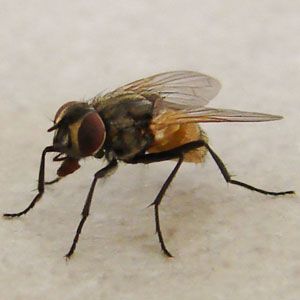 Order : Diptera
Order : Diptera
Family : Muscidae, Fanniidae, Calliphoridae
Size : 4 to 10 mm
Location : any habitat
Period : all year round
Of all the flies that can enter homes, there are 4 main species :
- the housefly (Musca domestica),
- the stable fly (Stomoxys calcitrans),
- the small housefly (Fannia canicularis),
- Attic fly (Pollenia rudis).
The adult fly feeds on plant and animal debris, sweat, excrement and blood (stable fly). The larva feeds on manure, detritus and rubbish.
The fly is highly invasive

Flies have colonised every part of the world where humans live.
Present from March to mid-November in our homes in various forms (larvae, nymphs), it doesn't stay indoors all day : in the evening, it takes a trip to the garden, the compost, the manure or the duck pond.
In the summer, they take up residence in the cool, dark living rooms, and in the attic during the winter.
Although not very pleasant, most species of fly are useful in our ecosystem (food for birds and fish, transforming compost into humus, etc.).
How does a fly walk on the ceiling without falling ?
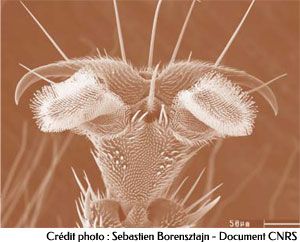
Microscopic view of the tip of a fly's legAs you will have noticed, the fly is an exceptional acrobat ! It's the most gifted of all insects when it comes to moving around upside down. But... it's not magic ! Sorry to disappoint you ! It actually has what look like suction cups on its legs.
In fact, at the end of each leg it has 2 curved claws, 2 adhesive side pads and a 3rd pad called the empodium. It is this whole system that enables flies to literally stick to ceilings or smooth vertical surfaces. Of course, other insects other insects can do it (bugs, beetles, wasps, bees, ants, etc.), but flies are still the best equipped to perform this kind of feat !
Flies also have a high surface-to-volume ratio. In other words, they occupy a small volume for a large body surface area. Because of their low mass, they are more subject to surface forces - such as adhesion to the surface they are on - than to the force of gravity.
What attracts flies ?
1 - Smells : In the house or flat, flies are attracted by smells. Whether it smells "good": perfume, fresh food (raw or cooked), sugar, fruit, vegetables, vinegar, etc. Or "bad": decomposing organic matter, excrement, sewage odours, rubbish, etc.
And the hotter it gets... the more the odours are amplified. It's easy to see why there's an abundance of flies in homes and other places in summer. Some flies are baited by us humans, because we are made up of sodium and other minerals (tears, perspiration) that are salty.
2 - Decomposition foods : vinegar flies are most attracted to fruit and vegetables that are too ripe or rotten. But that's not all (unfortunately), especially on hot days. They are particularly fond of used tea or coffee capsules, wilted or decomposing bunches of flowers, organic matter in rubbish bins and the bottoms of drinks (bottles or glasses of beer, wine, vinegar or cider). They are totally seduced by all these acidic and/or sweet foods.
3 - the farm and stables : These areas are full of odours that flies are particularly fond of (especially autumn flies). Cattle, horses, ponies, donkeys, etc. are very popular with these little creatures. They feed on the fluids they secrete around their eyes, mouths and snouts. What's more, manure, fertiliser, fresh excrement and organic or vegetable matter attract flies, which sense the potential for reproduction in these places, especially if it's hot.
Flies carry germs
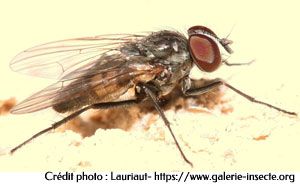
This insect is one of the main carriers of germs. Its body is teeming with millions of bacteria and it often deposits them on food.
The reserves accumulated during the larval stage are enough to keep the adult alive. It does, however, need a supply of sugar, which comes in a variety of forms: nectar, pollen, honeydew, milk, sweet liquids, meat, fruit, etc. Although they are not great travellers, flies can cover several kilometres in order to feed.
The partially digested liquid substances are then sucked up. While it feeds, it regurgitates part of its previous meal (the famous fly droppings!) and it is mainly in this way that it transmits pathogenic microbes to our food.
So be careful not to use ultraviolet traps or electric grids. As soon as the fly comes into contact with these devices, it explodes and the debris full of pathogenic micro-organisms spreads over a radius of 3 metres, contaminating everything.
The fly reproduces very quickly !
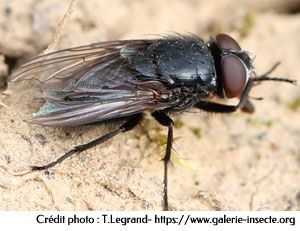
Reproduction takes place in summer, when conditions are most favourable. A fine summer suits it, but too much heat is fatal: above 30°C, it becomes sterile.
Its preferred breeding areas are warm, damp places such as rubbish dumps, uncovered human excrement, droppings, rubbish, carrion, manure, dung, meat, cheese and rubbish bins.
Depending on the heat and humidity, the eggs hatch after 8 to 24 hours and become larvae (also known as maggots), then nymphs for a short period, before transforming into flies proper.
The adult lives for 10 to 12 days. There are 10 to 30 generations per year.
A single female can lay up to 1,000 eggs, in several clutches of 150 eggs each. Under the best conditions, she can mate 2 weeks after hatching and lay eggs 4 days after mating.
Special fly sprays containing pyrethroids fortified with DDVP should be avoided, as flies can easily develop resistance to sprays due to their rapid reproductive cycle.
Also beware of insecticides beginning with "BIO" that contain permethrin (an organochlorine pesticide in the pyrethroid family). Although this product is biodegradable, there is nothing natural about it (synthetic) and even less organic about it. The toxicity of permethrin to humans has not yet been classified, but it is highly toxic to all cold-blooded animals and is not tolerated by cats (it can cause convulsion-type symptoms).
Also look out for insecticides that say "naturally active" in bold type. Manufacturers know how to attract your attention and sell you products that are not as natural as they claim. Most contain other ingredients such as PBO (pyperonyl butoxide) or permethrin !
At Penn'Ty Bio, we offer natural insecticides with no additives or petrochemicals.
Our tips for reducing the number of flies
1 - Keep rubbish away and maintain an impeccable level of cleanliness
Before any curative action is taken, a number of preventive measures can be applied to limit the presence of flies. In your home :
- Deep clean behind your furniture and appliances.
- Clean the bottom of your bottles of soft drinks, vinegar, spirits, etc. before storing them.
- Keep doors and windows closed at night, otherwise install a mosquito net.
- Protect your fruit and vegetables with bulk bags or protective covers.
- Have a dustbin with a tight-fitting lid and wash it twice a month with vinegar and water.
- Clean up after your animals (clean bird feeders, you can even remove the food for the night).
And in farm, stable or henhouse buildings, if you haven't already done so, you need to apply a minimum of basic rules to limit their reproduction and feeding :
- Keep all piles of manure, rubbish, sewage, rubbish bags, etc. away from the building. all decomposing organic matter.
- Clean out the ventilation systems to dry out the buildings.
- Always keep drinking troughs and feeding troughs clean.
- Do not leave milk deposits near the milking parlour or feeding area.
- Bedding should be as dry as possible (water troughs at the right height, renewal, ventilation).
- Slurry pits: stir regularly to destroy developing larvae.
2 - Touching breeding areas
You should try to stop their development by treating all the areas where they can reproduce with our 4J insecticide diluted to 5% (allow 500ml / 5m2 of surface treated).
3 - Mass elimination
You should try to destroy as many flies as possible. The more flies there are, the more they will lay eggs and the more you will have. There are many ways of doing this, but they're not always effective ! Flies are still 100% difficult to kill.
3a. Mechanical methods
These are still the easiest to use and are in no way harmful to us or our environment: the timeless fly swatter. Its long handle and flexibility make it a formidable weapon ! Then there's fly tape, of course, as well as fly strips for windowsills and hoovers.
As far as the hoover is concerned, avoid leaving flies in the bag, otherwise you risk ending up with a colony of larvae! You can spray an insecticide through the suction tube, but be careful never to use a flammable insecticide, otherwise you risk your hoover catching fire.
3b. Chemical products
Most shop-bought products are not always effective and, above all, not always healthy. Read your product label carefully, especially the precautions for use. Don't forget to look out for the mandatory pictograms !
To treat the air in your home, use Ecodoo aerosol or Aries flying insect repellent, 2 products composed of plant alcohol, essential oils and plant pyrethrum, specifically developed to combat flying insects. This type of product is highly effective, but only occasionally, as the flies will return as soon as you open a window or door! Plant pyrethrum without additives does have its advantages, but its shelf life is limited (it doesn't last very long), so you'll need to use it regularly. All Insectes Pistal insecticide can also be used as a direct spray. Immediate effect !
Finally, still on the subject of fumigation, Habitat Biovétol fogger will give excellent results on this type of insect. An insecticide based on active ingredients of plant origin (pyrethrum + geraniol), designed for basic treatment of the home. Highly volatile, the solution settles in the smallest nooks and crannies where parasites and insects live. Immediate action. 3 different formats are available: 75ml for treatment of less than 15m², 150ml for treatment of less than 30m². Finally, 250ml, for a treatment of more than 30m².
4 - To keep them at bay
Once the number of flies in the room has been reduced sufficiently, you can protect your space against the intrusion of new flies. You'll need to treat all the places they can enter (curtains, net curtains, door frames, etc.) as well as all the surfaces you want to protect. The aim is to create a repellent volume.
But, I'm sorry to say, there's no such thing as a miracle repellent! At best, a repellent will protect a few dozen centimetres around the treated surface. The more surfaces you treat, the better protected you'll be, but you won't get rid of all the flies.
4a. Our Pyrethrum/Geraniol insect repellent has been shown to have a highly significant intrinsic repellent effect (94%) on flies (and 98% on mosquitoes) when applied directly to the inert surface, as well as a residual repellent effect lasting two weeks. Use 500 ml to treat 5m².
4b. Our second Habitat Insect Repellent containing Eucalyptus citriodora will also give very good results and provide an ideal barrier against flies.
4c. Aries fly repellent offers another solution for protecting surfaces over a short period. It is available either as a spray or a concentrated solution (it can be used pure or diluted to protect the floor or garden furniture, for example).
4d. In terms of repellency, our mosquito and flying insect repellent spirals will keep flies at bay. The smoke from these spirals is made from pyrethrum. Flies will be immediately disturbed and will move on, or even die if they insist. Up to 5h30 of combustion per spiral.
And if you have a horse, pony, donkey or even a cow, our ALT'O ZINSECT insect repellent (spray or gel) will be perfectly suited to protecting them from the flies that swarm around them during the summer months. A 100% plant-based formulation combining 3 recognised, highly effective active ingredients to keep those nasty flies that spoil their daily lives at bay.
5 - 100% natural methods
- Known since the Middle Ages : In the event of a massive infestation in a room, close the shutters in the middle of the day to create half-light, leaving only one shutter ajar and the corresponding window open. Attracted to the light as if by a magnet, the flies will all be out within an hour or two.
- The traditional homemade trap : glass trap or plastic bottle to hang or place on the floor, add water and honey or a little sweet syrup, the flies will be attracted by the sugar and will drown in it. If you're using a plastic bottle, don't forget to collect the top of the bottle and turn it upside down to create a funnel on the bottom.
- Cloves and lemon : Stick cloves into lemons or other citrus fruit and place them in windows and doors. Replace them every week, as this will repel flies.
- Vinegar : Dilute white vinegar in a little water and place the mixture on your windowsill. Flies will no longer dare to set foot there. Washing your home with white vinegar is doubly effective, as it disinfects your home and repels flies.
- Essential oils : Geranium, peppermint, citronella, basil and eucalyptus essential oils are hated by flies. Put a few drops on your clothes or in a dish. There's no need to mix oils - just one is enough to get rid of them.
- Herbs : Place a few stalks of basil, mint or lavender around your home to repel flies. Alternatively, slice up some garlic or onions and place them in bowls on the windowsill, and that's all there is to it.
- Milk and sugar : Trap flies that are already in your home by creating a trap using milk, sugar and pepper, which they will then drown in.
Showing questions about fly
Q: I'm interested in your products, particularly the Insect Repellent, but to help me make my choice, could you answer the following questions ? - I live in the countryside, surrounded by fields, livestock and next to a pond: so flies + mosquitoes + spiders + cousins.... Is it better to use the "ready-to-use" repellent or to use a more concentrated dilution ? - My house has 10 windows + 1 bay + 3 external doors + 1 terrace: how much do I need to spray them ?
A: Don't expect to get rid of all the insects in the house, especially spiders, with a repellent product. The more concentrated a product, the greater its range of action. It depends on what you want to treat to limit the penetration of flying insects. Shelf life depends mainly on exposure to sunlight (degradation) and heat (evaporation). Let's say every week to start with, increasing or decreasing the frequency depending on the result. A 0.5l spray bottle will treat 5 m2 of surface area, but only treat non-absorbent surfaces, otherwise the product will penetrate the surface and lose its effectiveness. Preferably treat curtains rather than uprights, especially for 80 cm openings.
Q: We are invaded by flies. We have cows not far from our house (see the black ceiling of flies mainly in September) but there are flies all year round. Do you think that with these 3 products, insect spray + repellent spray + fly repellent, we could get rid of them ?
A: It's very difficult to get rid of flies completely unless you eliminate the source of the proliferation. However, when used correctly, repellents can help you to have far fewer flies. Insecticide is only useful for killing them by spraying on them. There are also fly repellent granules and tapes.
Q : Isn't there a risk of my dog being poisoned if he swallows insects (mainly flies) that have died with your product?
A: There is no danger, the product itself is not dangerous in normal use, and even less so eating treated insects.
Q: We have a septic tank and as soon as the weather's fine we get flies coming out of it and we've actually got some in the house; do you have a solution ?
A: I also have a septic tank but I don't have any flies. The tank is perfectly watertight, so I think that's the solution, but if that's not possible, you can always use fly repellent, granules or ribbons to combat them.
Q : Hello, can you tell me if I should use the anti-fly concentrate plus insect repellent for more effective action against stable flies. We're in the countryside next to a farm with cows and sheep. Thank you
A: ARIES fly repellent (concentrate or spray) is a good repellent. I also know that our Penntybio repellents are effective on flies (the pyrethrum-based one and the eucalyptus citriodora-based one). It's up to you to use them according to the surfaces to be treated. There are also fly repellent granules and tapes.
Q : I own a flag in the campaign. My attic is finished, my problem is that for several years in the unfinished part, I find hundreds of flies on the ground. My roof is in flat tiles and I have no roof, flies can pass. I don't have a dead bird either. Can you tell me why I have so many flies there and tell me what solution could I adopt to remove them. Would a treatment be worth trying despite the fact that my attic is of course ventilated ?
A: Finding dead flies in an attic is normal. Often they manage to get in but not get out. On the other hand, that there are a lot of them, that is not normal. I have no explanation, this happens frequently in sparsely occupied vacation homes. Our insect repellents are effective on flies. They allow a protection of 2 to 3 weeks. Apart from treating your tiles on the inside, I don't see too many other solutions. We have never tried this technique !
Q: My attic is invaded by flies and it even makes noise at night, there are so many of them. Can you tell me which is the right product? Thank you in advance and congratulations for your site and your products.
A: It is not easy to treat in an attic, considering that the space is often very ventilated. We can try to treat the interior roof with our insect repellent, this should limit the entry of new flies. At the same time, you can destroy the flies already present with our 4J insecticide.
Q : For 3 years my dog has been attacked by flies since April and this for 7 months. They suck his ears in particular so much that he bleeds and that every day. I have already tried various products, in particular grindstone for horses, I would like to find a product that is much more effective and that I don't have to apply every day.
A: We only have one product that might be suitable: ALT'O ZINSECT spray or gel insect repellent. which you will find on our website.
Q : In summer I have a lot of flying flies and mosquitoes in my apartment, could you advise me on essential oils or repellent. On the other hand I have a cat and I have heard that essential oils are toxic for them. What is it really ? THANKS
A: You have a ready-made blend on our site in Essential Oil Synergies: Peaceful Nights. For the cat, essential oils can be dangerous but only when applied to the skin (see our thematic file on this subject).
Q: We live in a house with a large bay window (2.40) and many openings (windows) and since the beginning of summer we have been invaded by flies. What should we do to try to reduce this nuisance, knowing that we have 3 children aged 8, 6 and 2 years old. So we don't want to use toxic and dangerous products. Give us the procedure to follow and the products to buy. PLEASE THANK YOU
A: You don't have a lot of solution, either natural or chemical. The only solution I see would be to put curtains in front of the bay window. You can possibly treat with repellent; for small openings, treat only the frame. To kill them, you also have the pellets and the tapes against the flies.
Q: We get swarmed with flies on the patio when we have lunch or dinner. Do you have a repellent to diffuse in order to keep them away effectively ?
A: Unfortunately, there are not many fly solutions. Personally, I kill them by spraying them with 4J insecticide diluted to 5%. If you have a lot of them, I recommend a garden type sprayer and you water them all. After a few days they should go away. You can also place our fly pellets in a corner.
Q: 10 days ago, the smell of rotting flesh was detected in my cellar. Of course I immediately tried to find the decomposing animal in my garden. Unfortunately it seems to me that this one went to die under my stone staircase, an inaccessible place... Currently, maggots (fly larvae) have invaded the ground bordering this staircase. What can I do to eliminate them ? I know the best way to do that is to find the body; but in my case it is almost impossible !
A: In this case, it's actually quite complicated. There remains the solution of treatment by fumigation using our Habitat Biovétol fogger. By trying to place it as close as possible so that the fumes enter under your staircase. As for the corpse, if you don't have access to it, you'll have to wait for it to decompose on its own.
Q : My mother lives in an old house and the toilets are original, septic tank. It is invaded by flies and we cannot destroy them. Can your product be put in the pit, safe for my mother and will she be quiet afterwards, no more invasion. Please let me know your answer because I don't know what else to do.
A: I don't really see how to use our products which are biodegradable in a pit full of bacteria! You can treat the flies present but you cannot prevent them from returning. I also have a septic tank but I don't have any flies. My pit is perfectly sealed and no fly can enter or leave. See rather on the side of your pit what can be done.
Q : I am looking for a fly repellent which we are regularly infested with in the summer when leaving windows and doors open, something non-toxic for humans, we have young children.
A: We have various repellents on our site, exclusively based on natural products which give good results in repellent. Another solution, to kill them, you have our 4J insecticide or granules and tapes against flies.
Q: I am a farmer and I have lodgings on the farm and I am invaded by flies in my buildings. I would like documentation on this subject. Also if you have a stand at the agricultural fair in libramont (Belgium) let me know thank you for your response.
A: We have various repellents on our site based exclusively on natural products which give good results as a repellent. Another solution, to kill them, you have our 4J insecticide or granules and tapes against flies. Due to lack of time, we are not taking part in any demonstrations.
Q : We have a small rabbit farm and are being invaded by flies this year. can we use your insecticide in the building where the hutches are located: is it safe for rabbits ? what concentration to choose knowing that the building has openings (which do not close and on which we have placed mosquito nets) ?
A: You can safely use our insecticide on your farm. It is authorized in organic farming. For flies, they should not go below 5% (standard concentration for all insects). You can treat with insecticide all the surfaces where the flies are in order to eliminate a maximum of them.
Q: I am a poultry farmer. I have problems with speckles breeding in droppings. How do I get rid of it? The surface to be treated is 2000 m/2 and this twice a year. Which product? What success ? How much per treatment ? What price ? Delivery in Belgium possible ? Thank you
A: The three strengths of our insecticide are: non-toxic, insect killing and egg killing. As speckles are small insects, I think a 2% concentration should be enough to try. To be effective, we recommend 1l of insecticide / 10m2. You can first take a small bottle of insecticide to do some tests and if the result suits you. Thereafter, you can consider treating all of your surfaces. We deliver in Belgium without worry (see shipping costs table).
Q: I don't know which product to choose. We are going to live in the countryside near the stables and we have flies galore, plus tiny "wasps" that sting. The main room is 70m2, and is duplex. We have a parrot, 2 cats and dog. What can you advise us in this context, which is more than effective and above all non-toxic for us and our animals ? There are too many choices, and I'm a little lost. Do you have anything else as effective that isn't in sprays ?
A: To protect against flies and safe to use and not spray you have: sticky tape and fly pellets.
Q: I have a chalet in the mountains (1600 m), and I am invaded by flies and horseflies, especially on the larch facades and then inside. What effective and lasting treatment do you have to offer me ?
A: For exterior treatment, we can offer you our repellent to spray on facades, but you should know that no natural (or unnatural) product resists the sun for very long. It can be used indoors. Otherwise, it is possible to use the traditional fly catcher tape, not very aesthetic but effective, and the granules, well placed, are effective.
Q: We have thousands of flies on our front walls (we are near a cow field) What do you recommend ? Do you have points of sale in department 69 ?
A: You have the solution to kill them, at least those on the facade, with our 4J insecticide diluted to 5%. Equip yourself with a garden-type sprayer and water the flies. Those touched by the product will die. It won't stop other flies from coming. You can start again until you run out of flies or product! we can also treat the wall with our insect repellent but if it lasts 3 weeks, in direct sunlight, it will last much less.
Q: I want to diffuse essential oils in my house, in addition to the insecticide and repellent you offer, to drive away many flies. Indeed I have a large bay window and I think that the repellent will not be enough, and moreover I am a little afraid of staining my fabrics so I will complete by diffusing. What mix do you recommend ? I was thinking of taking geranium, lemongrass, thyme, lavandin, cloves. Knowing that I have a 1 year old little girl, can it be dangerous, what essential oils should I avoid ? I think I'll also take your "child's night" mix for her since it's made on purpose; on the other hand, you specify on your page not to use essential oils before the age of 3, which is why I am wondering about my "anti-fly" broadcast !
A: If for mosquitoes we know the effective essential oils to keep them away (since the goal is to mask human body odor), for flies, it's a little more complicated. I have no idea of the essential oils to use, however I do not recommend diffusing thymol or even cloves in the presence of young children. You will find information on the diffusion of essential oils on our site.
Q: I have received your email, concerning insecticides, but I would like you to tell me which product is effective against flies, which have been inhabiting my attic for at least 4 or 5 years, despite a roof remodeling where they have not found nothing, as well as having used the "KAPO SHOCK CRAWLING FLYING" smoke product several years in a row, we are unable to stop this invasion. thank you for giving us the miracle solution.
A: We regularly have requests like yours: a fly-infested attic. If there are flies present, it is because they are finding something to reproduce (animal excrement, corpses, manure, etc.). The question is, do they breed outdoors or indoors ? Is your attic closed and insulated, do you have Velux windows ?
Q: We have a closed, insulated attic that is all black. When we look with a lamp, we do not see flies flying, nor dead. On the other hand they manage to go down in the rooms below, certainly attracted by the light, but impossible to see them leaving a precise place, except to see them dead in front of the windows, that is to say the light. Is KAPO CHOC CRAWLING FLYING SMOKE powerful enough, because we have been using it twice a year for at least 3 years. Do you have another product to offer us or to experiment with ? the rooms are not occupied.
A: In general, flies are attracted to warm, bright places. Flies are rarely found in a dark place. Why do you think the flies go through the attic since you can't find any (neither alive nor dead) and this place is dark ? It is possible that they arrive directly in the rooms without going through the attic. The Kapo is effective, it will kill the insects present in the room but that's all; it will not kill the insects that are behind a partition or those that will come after. Unfortunately, there is no miracle product to fight the fly apart from attacking the source of the proliferation, but when it is behind a partition, it is impossible or block all access with silicone. We brought in some very effective special fly pellets from Kapo.
Q: My attic is overrun with cluster flies (Pollenia rudis). What product from your range would you recommend to scare them away? I do not necessarily seek to kill them, but to dislodge them because they come out at the first ray of sunshine and "decorate" by the thousands the white facades of our house. Is the smoke pyramid effective for these flies ? What is its duration of action in repellent mode ? What time of year should it be used ?
A: Attic flies have a habit of hibernating by sheltering in every nook and cranny of the house. Due to their small size, the attics and attics of houses are easily accessible places for them. They can gather in the hundreds in clusters waiting for the temperatures to rise. When spring arrives, they then seek to go out. They don't always find the exit. This is also why we can find them around the doors and windows of our homes. Loft flies do not cause damage but can be particularly troublesome due to their large numbers.
The adult attic fly feeds on the nectar of flowers, so it is brought out of your home to feed.
You can choose not to eliminate them, but be aware that this insect can reproduce extremely quickly, up to 4 generations per year if the temperatures are high. I advise you to proceed as follows.
It is important to locate the nest and the access points. You can proceed in 2 steps:
First a treatment with our 4J insecticide. It exists in its already diluted and ready-to-use form at 5% (recommended concentration against flies), or in its concentrated form, which will allow you to treat larger areas (up to 200 m²). For the concentrated product, you make the 5% dilution with water in a garden sprayer. Direct spray application to visible flies and accessible crevices. This insecticide is a contact insecticide. For it to work properly, it must therefore be able to bring it into contact with insects (eggs, larvae or adults).
In a second step, you can put in place a repellent to prevent flies from re-establishing themselves in the premises. For this, we have 2 products that will work, with 2 different active ingredients. One is pyrethrum geraniol repellent. It exists as for 4J, either in ready-to-use form, or in concentrated form. Or our Habitat insect repellent made from eucalyptus citriodora. Like 4J, to be applied by spraying on surfaces.
Finally, if you wish, you can use the smoke pyramid or our Habitat fogger. That should eliminate a good chunk of it. Its duration of action remains limited (a few hours) since it is an insecticide. It can be used at any time of the year. The one where the number of flies is the most important being the most effective. Do not forget to condemn the identified access points (as far as possible of course). This will limit their reinstallation.






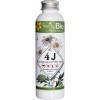
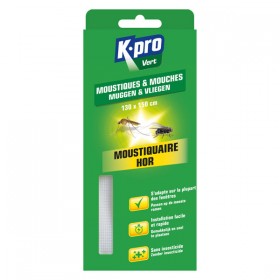
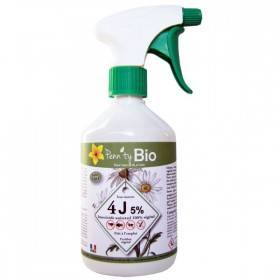
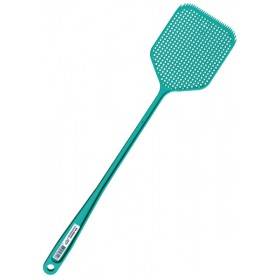
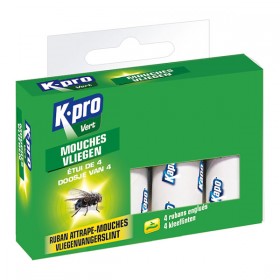
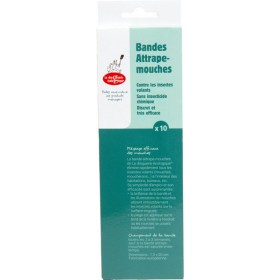
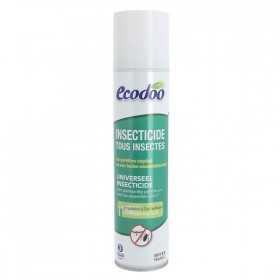
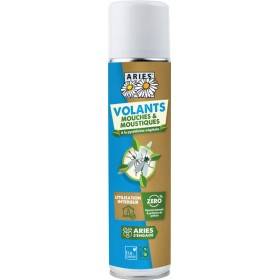
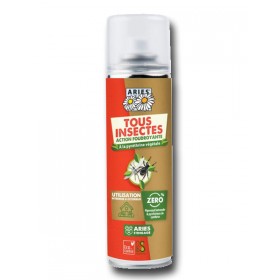
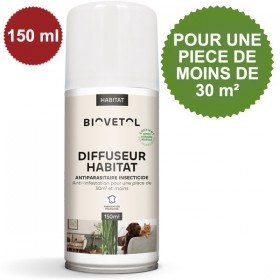
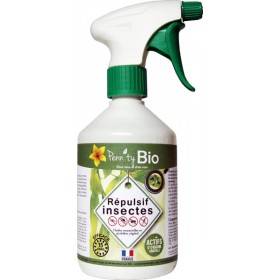
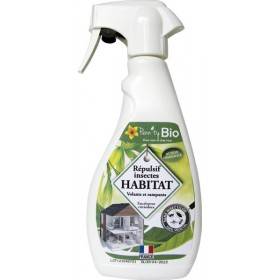
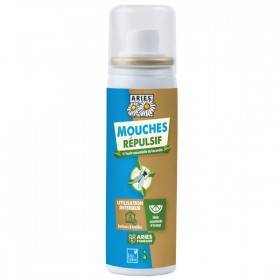
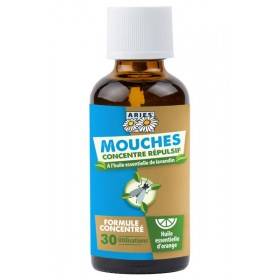
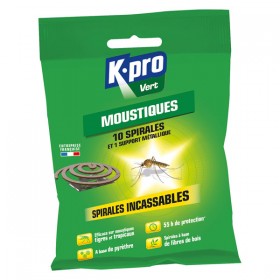
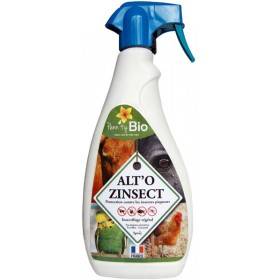
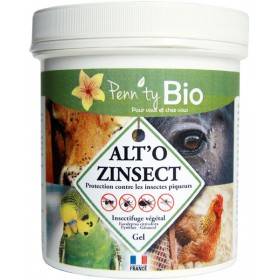
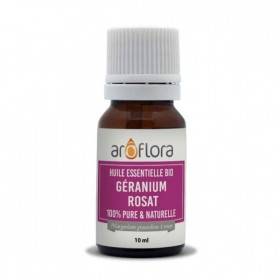
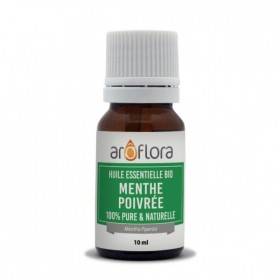
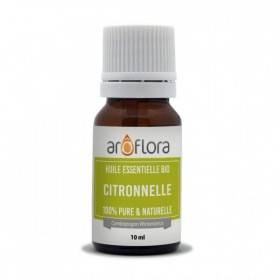
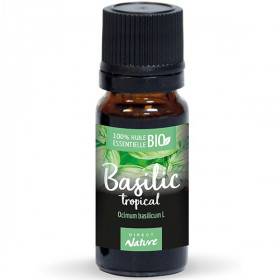
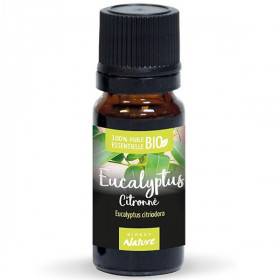
Customer reviews
Je suis arrivée sur votre site en cherchant un diffuseur que je viens de commander, mais je voudrais vous dire que votre site est très intéressant, bien fait. Vos dossiers sont enrichissants merci
Joelle
Je vous remercie de votre professionnalisme et de votre réactivité.C'est loin d'être toujours le cas lorsque l'on commande sur internet.
Gaëlle
Livraison rapide et très bien emballé et protégé. Très bonne efficacité. <br /> <br />
XX
Merci pour votre geste que j’apprécie.<br /> Cela fait plaisir de retrouver l’esprit commerçant de proximité chez un vendeur en ligne. Je surveillerai attentivement cette nouvelle livraison.
Philippe
Bon produit. Merci Penn'Ty Bio. Un seul passage dilué à 5% et les puces ont disparus. Il en restait deux ou trois qui ont dû se perchés pendant le traitement mais sinon c'est performant.
Axel
Livraison rapide et produit conforme à la description. J'approuve à 100% le principe du recyclage des éléments d'expédition. Un produit fabriqué une fois soit avoir plusieurs vie. Bravo pour cette initiative.
Christophe
livraison tip top tant en temps et en qualité.
XX
Sophie. A
Envoi très rapide et bravo pour votre site de reconnaissance des insectes nuisibles.
Brice
Boutique très sérieuse avec un envoie rapide et des produits super efficaces.
XX
super contente, j'y trouve facilement les produits dont j'ai besoin et le service est impeccable et gentil !
Hélène S.
Suite à un précédent message notifiant une erreur de produit à la livraison, Penn'Ty bio m'a fait parvenir à titre gracieux le bon produit. Merci
Martine
Mon avis sur penntybio, très bon produit sur ce site pas une gamme monstrueuse mais que du très bon, et pareil pour les livraisons ultra rapides et le excellent sav si besoin. Je recommande vivement. Client depuis 2018 aucun soucis.<br /> <br />
thierry g.
Merci pour votre sérieux et la réexpédition ultra rapide d'un achat non conforme (dont vous n'étiez pas responsable).
Marc
très bien livraison dans les délais, colis intact, bon produit.
Martine
J'ai bien reçu le diffuseur et j'en suis très content.
Paul
Les produits commandés sont conformes à mes attentes. Quant à l'accueil au téléphone, il est parfait et nous avons toujours trouvé un terrain d'entente. Je fais confiance à Penntybio.<br /> Merci.
XX
Penn' Ty Bio, c'est ma référence depuis 10 ans au moins. Je ne commande mes produits de toilette et d'entretien que chez eux. Les marques et le service est irréprochable.
GAELLE
Merci pour vos conseils avisés. Et merci pour vos produits de qualité.
Loïc
Très bon site. Envoi rapide. Prix moins cher que sur d autres sites. Bravo et bonne continuation.
Camille
J'ai bien reçu ma commande. Com' dab' , rapidité efficacité ...Merci
Sally
Excellent service et livraison rapide. A conseiller pour la santé des animaux (chiens et chats)
MICHEL
colis reçu ce jour, merci pour le flacon offert
Andrée
Client depuis plus de 10ans. Toujours satisfait du matériel propose. Boutique sérieuse prix compétitifs livraisons et suivis rapide.
XX
très satisfaite de ma commande site vraiment sérieux livraison soignée et rapide ,les articles sont conformes a la description,je suis enchantée et recommande vivement
Marie Viviane C.
Bon site, fiable, rapide et efficace.
Leo L.
livraison impeccable, produit bien emballé et correspondant au descriptif, excepté pour la surface de diffusion, ma salle principale doit faire 25m2 maximum et ça ne se diffuse pas au-delà.
Pascale
je viens de réceptionner ma commande. Tout est ok. Merci pour ces produits respectant l'environnement et l'être vivant.
Anatole
Envoie soigné et rapide.<br /> Merci pour le petit mot à la main.<br /> Très appréciable.
XX
Produits de bonne qualité, naturels et efficaces, expédition rapide et bien emballée, sav très rapide suite à une erreur de ma part,
XX
Merci beaucoup pour l'info, c'est rapide chez vous, très appréciable!
Denis
Super efficace !!!
xx
Très satisfaite des délais, les produits sont bien emballés et le petit mot sympathique est fort agréable!<br />
Sylvana
Content des produits achetés, reçu rapidement et bien emballé. Merci.
XX
Merci et bravo pour la qualité des produits et du service toujours aussi efficace et performant.
Annick P.
Comme d'habitude, envoi soigné, produits performants, Merci.
XX
Très bonne adresse où l'on trouve des alternative aux produits chimiques notamment contre les insectes. Le service client est également de très bons conseils.
ck
Rapide, sérieux et qualité, produit correspondant à la description, très contente, je recommande votre site et vos produits.
Corinne
Service rapide et efficace. Et Sympathique ! toujours un petit mot, ça fait la différence. Et c'est français en plus :). Je recommande.
XX
Merci pour le geste commercial, et aussi pour les nombreux conseils et l'excellent service client.
Tristan L
Site de grande qualité !
Rose Anne Marie
Super, livraison rapide, suivi très rigoureux, site de confiance, très sérieux à recommander... Merci pour tout.
Bernard
Je vous remercie beaucoup de m’avoir fait profiter d’un acheminement par Colissimo alors que rien ne vous y obligeait, sauf votre conscience professionnelle, chose rare de nos jours et qu’il ne faut jamais manquer de souligner.
Cécile
bravo pour votre réactivité et la qualité des produits
Annick P.
Un grand merci pour votre offre et votre professionnalisme. Pour un service en ligne, vous savez vous rendre proche de nous. Bravo et "suerte" !
Pierre M.
Françoise
livraison rapide ,prix raisonnable , produits super efficace j'ai vite calmé mes douleurs lombaires ...enfin soulagée . Merci pennty bio
JEANNINE
Félicitations pour la qualité de votre site & la valeur de ses informations ! Continuez ainsi ! On a besoin de vous !
Ronald
Très bien , bon produits, La prochaine commande avec plaisir, livraison très rapide.<br />
Rainer
Tout était parfait. Produit, prix, délai.
Marco
Cliente depuis plusieurs années. Super service, réactif, cordial. Les produits sont excellents.
Christine
Quel dommage pour le produit manquant, je vous remercie pour le remboursement.
Didier
Jamais déçue : les produits correspondent à la description et sont livrés rapidement.
Mireille
Toujours très bien et parfaitement emballé ! Merci<br />
Valérie
Comme toujours service "au top" réactivité, qualité produits... BRAVO et merci pour la qualité de votre travail
Annick
Bons produits. Fonctionnent très bien.
xx
Livraison rapide, emballage plus que parfait, le diffuseur NEOLIA est merveilleux pas bruyant, fonctionnement idéal. Merci PENNTYBIO pour votre sérieux, site web à recommander.
CLAUDE
Nous sommes très satisfaits du service client : mot personnalisé dans le colis, disponibilité du service après-vente... Nous souhaitons à votre société un succès croissant.
Sara
clair net précis. merci
jannick
Diffuseurs qui sortent vraiment de l'ordinaire, un envoi parfait - merci BCP
Anthony
Bonjour Monsieur,<br /> Nous nous étions parlés au téléphone il y a quelques années. Bravo pour l'évolution de votre site et vos dossiers instructifs. Vos produits aussi sont très bons. Bonne continuation, bien cordialement.
Marina
Efficacité de la livraison , très rapide . Produits livres en parfait état . Très bien emballés . Merci.
Geneviève
Les produits sont de bonne qualité. Leur prix est raisonnable. Ils sont livrés rapidement, et en bon état.
XX
Après essais de divers produits, votre insecticide 4J est le seul à être venu à bout des puces ramenées par le chat de la maison. Livraison rapide par chronopost
JEAN MARIE
Excellent site. Très à l'écoute. Livraison rapide. Problème avec un piège à guêpes un autre m'a été livré très rapidement. Chapeau et très agréable de tomber sur des gens compétents.<br /> Encore merci.
XX
2 commandes à mon actif et jamais déçue. Vous avez gagné une cliente régulière :) Merci pour votre sérieux et le contenu bien rempli de votre site ! c'est super d'avoir une description hyper détaillée de chaque produit.
Magali
MERCI au personnel à l’emballage !!! Ma dernière commande était super bien emballée. Elle a résisté aux (épouvantables) chocs subis pendant le transport. Merci
Veronique
Bonjour, colis bien emballé arrivé sans encombre, démarche écolo bien ancrée et petit mot perso. Merci à l'équipe de Penn'Ty Bio.
Sofi
Excellentes prestations. Les produits sont formidables, l'emballage aussi. Les délais d'expédition compétitifs. Je recommande vivement Penn'Ty Bio à tous ceux que l'état de la Planète pour les générations futures inquiètent.
XX
merci pour le suivi de ma commande et les mails par lesquels vous m'avez tenu informée.
Zoé
J'apprécie depuis de nombreuses années la qualité de vos produits et le sérieux de votre site. Une petite mésaventure avec un diffuseur me permet de vous féliciter pour la réactivité de votre SAV. Bravo !
Thierry G.
Claudine
Très contente d'avoir découvert ce site internet ! Du conseil jusqu'à l'achat c'est super. J'étais très embêtée après l'apparition de petit insecte chez nous (des anthrenes) et c'est le seule site internet e-boutique qui a pu nous renseigner dessus et enfin indiquer les produits pour les éradiquer sans pour autant nuire à notre santé (mais en respectant les conseils d'utilisation bien sûr). J'ai reçu ma commande rapidement, et avec surprise un petit mot de remerciement personnalisé avec mon nom dessus. Des détails qui au finale font la différence. Un service de qualité rien à dire. Merci !
XX
excellent.
XX
Livraison rapide et soignée. J'utilise les produits bio qui sont de très bonnes qualités. Un savon m'a été envoyée par erreur à la place de celui commandé et il m'a été remplacé très rapidement. Bravo pour leur réactivité. Je recommande fortement ce site.
Liliane
Livraison rapide. Produits bien emballés.
Bruno
SATISFAITE
ANNE
Livraison express. Colis toujours aussi bien préparé (cales, flocons, adhésif sur les bouchons qui risquent de couler). Bravo pour votre professionnalisme.
Isabelle
Bon produit , envoi rapide.<br /> <br /> <br />
Christine
Dimanche soir, invasion de vrillettes du pain. Lundi matin, commande en urgence des produits verts adéquats. Mardi, livraison, traitement et fin de l'invasion.
Jean-Pierre
Livraison efficace et bon contact oral avec mon interlocutrice.
Maussane
J'adore. Très grande diversité de produits, les explications sont simples et complètes.Quand aux colis, ils sont extrèmement bien protéger. Un grand merci.
Nadine
Merci pour votre envoi : rapidité, ponctualité, information de suivi du colis etc. Vraiment du bon boulot.
E.G
Livraison très rapide; Tout était parfaitement emballé. Je referai appel à vous.
JV39
Super produits accueil plus que parfait gentillesse. Livraison au top merci beaucoup
Christiane
Première commande chez Penn'Ty Bio : <br /> - navigation sur le site = 5/5<br /> - préparation du colis = 5/5<br /> - Prix compétitifs = 4/5<br /> - Qualité des produits sélectionnés = 5/5<br /> <br /> Vendeur à recommander.
Gaëlle
2 commandes à mon actif et jamais déçue. Vous avez gagné une cliente régulière :) Merci pour votre sérieux et le contenu bien rempli de votre site ! c'est super d'avoir une description hyper détaillée de chaque produit.
clara
En cette période d'avant Noël, je craignais que me colis arriverais en retard. 48h après mon achat, c'était dans la boîte aux lettres. Du coup, je suis large pour mettre mon achat sous le sapin. Merci à vous
Art4
accueil téléphonique personnalisé réactif compétent et bienveillant, livraison rapide et conforme. BRAVO merci pour la qualité de votre travail
Annick
rien a redire, sauf, le montant des frais de livraison, un peu élevé.
XX
Bonjour <br /> C'était ma première commande sur votre site et j'en suis très satisfaite <br /> Je vous remercie pour votre professionnalisme (site, prise de commande, livraison) ainsi que pour le petit mot qui rend le tout humain. Très belle journée.
CG
J'adore ce site qui fait un vrai travail de sélection de produits que je ne trouve pas ailleurs et sur une large gamme. Je recommande.
Veronique G.
Franchement, Penn'ty bio, c'est top ♥<br /> Quentin est super réactif, de très bons conseils. Encore merci de votre efficacité.
Hélios ☼♥
Boutique sérieuse. Commande arrivée très rapidement. Merci pour votre gentil mot avec la facture.<br /> <br /> <br />
I Defoy
Commande reçue assez rapidement. Merci pour votre sérieux.
Émilie
Une utilisation de vos produits a suffit pour nous débarrasser des poissons d'argent. Merci.
Matthieu
Excellents produits. Excellent service.
James T
Un super magasin en ligne, avec plein de produits disponibles.<br /> L'envoi a été très rapide et soigné, avec une très bonne communication à chaque étape. Bref, une adresse à connaitre et à garder ! Merci !
Pab57
C’est la première fois que je commande sur ce site et pas déçue livraison rapide de ce produit que l’on ne trouve pas partout. Je recommande
Patrick
Je suis ravi de trouver les produits de qualité et d ‘efficacité incomparable.
Denitza K.
Efficacité redoutable. enchanté.
Robert
Penn'Ty Bio wonderfully served our family in Switzerland so that we could try the range of Totemsavon products, which are such caring, loving, and consciously manifested creations :)<br /> <br /> By allowing a shipment to Switzerland and elsewhere, I am sure so many more people would be able to benefit from the beautifully selected product portfolio in Penn'Ty Bio and all, together, make a conscious leap by using and demanding a way more purer approach to anything we interact with.<br /> <br /> Thank you so so much Penn'Ty Bio!<br /> <br /> In 8 Love We Heart Trust<br /> <br /> Miguel Ángel
Miguel Ángel
Ma commande s'est déroulée sans aucun problème avec une livraison rapide et soignée. La satisfaction est au rendez-vs ! Continuez ainsi ! Merci et cordialement !
Etoile 07
Très réactifs entre la commande et la livraison. Je suis toujours satisfaite de mes commandes soigneusement emballées !
France L B
Explication, commentaire et livraison en un temps record, tout était parfait, même le petit mot de remerciement écrit à la main ! Merci beaucoup
Monique S.
Louise
Je viens de recevoir la pastille noire aujourd'hui et je vous remercie de votre envoi gratuit (ce qui est rare de nos jours).
Laurence
J'ai été TRES bien conseillée lors du contact. Produit naturel donc c'est parfait.
Lilla
Je suis très satisfaite de mon échange avec le service client (personne à l'écoute, de bon conseil). Envoi rapide et soigné, avec un petit mot sympathique de l'équipe, le top!
XX
Livraison rapide et fiable, dès que le chèque a été reçu. Produits de bonne qualité.
Chantal H.
Produit performant et raisonnable au niveau prix. Je recommande
XX
Vos produits sont de bonnes qualités et les produits très bien emballés
Dominique
Merci à tanteOdile pour m’avoir fait découvrir votre site. Depuis je suis une cliente assidue. Très satisfaite de la rapidité des envois, de la qualité de vos produits qui sont par ailleurs très bien détaillés par leur composition et leur mode d’emploi. Une amie vous a rejointe également avec la même satisfaction <br /> Continuez.
Marité D.
Bon produit, efficace et laisse une odeur plutôt agréable. Expédition rapide, emballé avec soins. Je recommande
Mary
Hélène
Je suis cliente depuis de nombreuses années. Toujours satisfaite du site, des produits et de la livraison.
martine O.
Je parlerais de vous a mes amies car vos produits sont vraiment excellents. Bien a vous et tous mes remerciements.
Patricia
Excellent service après vente après un problème d acheminement de colis par la Poste. Une relation client de très grande qualité. <br /> Cordialement,<br /> <br />
PV
Très contente de vos produits.
nathalie G.
Bravo et merci : produits de qualité et service TOP... continuez !...
XX
j'ai reçu mon colis aujourd'hui, merci c'est très rapide et sérieux.
Clara
Envoi rapide. Rien a redire.
Marie France
Tout était parfait l’envoi la livraison merci beaucoup
XX
Très bon produit, conforme à la description.
MICHELE P.
Avec les trois lettres BIO dans votre nom, je ne m'attendais pas à découvrir des billes de polystyrène comme matériaux de rembourrage. Il y a certainement plus écolo !
Michel D.
Merci pour l'expédition de la pièce de verrerie qui a été recu cette fois sans casse. Meilleures salutations et à très bientôt sur votre site pour un prochain achat .
Louane
Excellent site rapide et efficace. Descriptif intéressant.
XX
Livraison rapide et bien emballé. Petit message manuscrit qui fait plaisir :)
xx
Très bon site, très sérieux je recommande, produits de qualité et service après vente au top, de plus livraison des plus rapide et produits très bien emballés, tout est parfait
virginie
J’ai découvert cette société en faisant une recherche sur Internet pour trouver un insecticide contre les sclérodermes. Je ne peux pas encore juger l’efficacité de chacun des produits par contre je suis très satisfait de la rapidité et de la qualité d’expédition, ainsi que du sérieux de la société. J’ai même reçu un petit échantillon est un mot personnalisé j’ai trouvé ça très sympa! Merci beaucoup et bonne continuation pour votre société que je recommande déjà.
BJ79
Je me permets de vous écrire un petit mot afin de vous dire que votre site est très bien fait.
Tom
JM
J’ai bien reçu mon colis et vous remercie de votre rapidité. Bravo pour le geste écologique et durable. Emballage nickel ! Et mon chat a adoré jouer avec les billes jaunes !
Anouk
Une entreprise fiable, efficace, de confiance, chez qui je recommande de faire ses achats.
S.
1ère commande. Très satisfaite : Colis expédié très rapidement et bien emballé. Merci pour votre sérieux.
Ghyslaine
Je voulais non pas faire une réclamation; mais vous féliciter pour vos produits que j' ai bien reçue, et également pour la rapidité de votre envoi ce qui est plutôt rare dans d'autre site.
Jérôme
Toujours satisfait et pour les prix et pour les produits.
andré a.
Je confirme efficacité sur la préparation et expédition du matériel. un grand merci
Jeremy
Marie-Noëlle
Parfaitement parfait, je ne me fournis que chez Penn'ty bio depuis qu'ils m'ont débarrassée de punaises de lit.<br />
MARIE CLAUDE G.
Bon produits et service !
Rose-Marie
très bons produits et service commercial très performant, continuez sur cette voie, merci.
Annick
Très satisfaite.
Louise
Bon service et bon produits
Odile R
Super produits, envoi rapide et soigné, conseils et échanges courtois ! Une jolie boutique en ligne pour acheter en toute confiance ! <br />
Patricia
J'ai enfin reçu le petit colis, hier. Il a mis un mois pour me parvenir, mais vous n'y êtes absolument pour rien, comme je le pensais, il a été mis de côté lors de la grève nationale. Je vous remercie d'avoir fait faire des recherches, j'ai reçu un mot de la poste.
Hervé
C'est vraiment magnifique et ce cadeau a plu, je commanderais pour Noël.
Martine
Prix intéressants. Expédition super rapide à bon prix. Et tout ça de façon agréable !
Alexis M.
J’ai bien reçu le nouveau diffuseur fonctionnel après essai et je vous remercie pour votre confiance et votre rapidité sur le traitement de mon problème. Ce n’est pas tous les jours que l’on voit un SAV aussi efficace !
Florent
Tout est parfait de la commande à la réception. Commander jeudi et reçu samedi. Et très contente de mon achat . Je recommande
Nadege M.
livraison rapide, produits bien enveloppés avec juste un petit bémol : pour l'imperméabilisant dont le couvercle n'était pas bien fermé.
Alain
super emballage écolo...bravo !
Isa
trés satisfaite de ma commande,( produit, et livraison,rapide ) MERCI
Danièle M.
Modèle conforme bien emballé délai respecter continuer comme ça parfait.
Carlos
Bonjour. Je souhaite vous remercier pour votre rapidité. Le colis est arrivé en bon état . Les huiles que nous avons commandées embaument la maison. Ce diffuseur est génial.
Christian
Bons produits conformes à mes attentes et livraison au top. Je recommande vivement.
Chantal P.
Site très sérieux et personnel vraiment agréable. Envoi rapide. C est parfait !
Ingrid
Merci pour cette première commande, envoyée très rapidement, et dans un petit colis, avec frais de port très raisonnables.
Valérie O.
très bien je recommande.
Sylvie
Livraison rapide , produits de qualité, je recommande Penn'Ty Bio.
XX
Cliente depuis plusieurs années, j'apprécie toujours ce site. Meilleures salutations.
France
service très efficace à chaque fois que j'ai commandé. aucune mauvaise surprise sur la livraison. je recommande
Agnès
Livraison rapide , le tout correspond à mes attentes.
Julie
Je tenais à vous remercier pour votre service de qualité, une livraison toujours rapide, des colis bien emballés - qui évitent fuites et casse, ainsi que pour le petit mot personnalisé joint à chaque commande, c'est toujours très agréable.
Isabelle G
J'ai reçu mon colis hier. Merci de vos démarches,
Sam
Très satisfait du site livraison rapide.<br />
Michel
produit parfait.
René
Personne disponible, de très bon conseil suite à des punaises de lits dans mon habitation, les produits sont efficaces car depuis aucune punaises et la vie à repris son cours ... merci pour tout
Nathalie
Parfait comme site, commandes faciles à faire et livraison rapide !
Cindy
J'ai reçu le colis, merci beaucoup de votre promptitude et bonne continuation.
Louise
Merci beaucoup pour la rapidité avec laquelle vous m'avez fait parvenir le diffuseur.
Bichette
Efficace rapide et à l'écoute. Diversité des produits. Efficacité des produits. Respect des délais de livraison et prise en compte des spécificités client PMR ( ce n'est pas toujours le cas). Site bien fait pour navigation et produits bien mis en valeur. Des promos et des bons de réduction cumulés en fonction des achats. Merci pour votre efficacité rapidité et professionnalisme.
xxx
Produit conforme aux attentes.<br /> <br /> <br /> <br />
Alain
Emballage au top. Livraison rapide et sans dégâts.
xxx
Parfait comme d'habitude
Sylvain
fidèle cliente de Penn'Ty Bio, je ne me fournis que chez eux.
XX
Je voulais juste vous remercier. J ai reçu mon répulsif " lézards" aujourd'hui, un petit mot super gentil joint à ma commande ça fait plaisir. J espère que ça va fonctionner. Bonne journée à vous et merci.
Cynthia
Livraison très rapide et colis emballé soigneusement.Site à recommander.
isabelle d.
Rien à redire, de la commande à la livraison.
XX
Toujours parfait, livraison, emballage, délai et gentil petit mot personnel pour me remercier de ma fidélité.
XX
merci pour votre professionnalisme. Merci pour les produits envoyés dans de bons délais. Merci pour la qualité de vos produits
Marcelle
Commande reçu en 2 jours, impeccable. Tous les produits emballés avec le plus grand soin, petit mot personnalisé! Et encore un petit savon bio au parfum délicieux comme cadeau!! Merci Penn'Ty Bio !!
Orchidée
Je ne connais pas encore tous les produits mais contente de ce que j'ai commandé. En revanche un peu cher quandmême ce qui me limite.
xxx
Très bons produits, service rapide et de qualité, rapport qualité/prix intéressant. Je recommande vivement.
Alain
Très bon site, du personnel sérieux et la livraison en temps et en heure. Merci
Marine T
Livraison conforme et rapide. Les produits sont emballés dans des emballages recyclables, voire compostables : j'ai beaucoup apprécié. Je recommande ce site.
Patrick
Très bien...merci.
Olivier
Rapidité, emballage nickel et écologique, mot de remerciements personnalisé, produits au top....j adore....je suis une nouvelle cliente conquise. Un grand merci...
Hélène P.
Livraison rapide et avec colis préparé avec soin :)
Florian
C'est extrêmement délicat de votre part d'avoir fait diligence. Je ne manquerai pas de recommander votre site et de souligner votre gentillesse. Encore merci
Michel
Commande bien reçue . Je suis très satisfaite Merci pour votre sérieux
LILIANE
Beaucoup de soins dans la commande reçue. Je recommande!
XX
Tout est parfait : la qualité des produits, la rapidité d'expédition, la qualité du colis. Je suis enchantée et resterai fidèle à ce site.
Dominique
Hyper cher :: très déçue du prix par rapport à la quantité de produit acheté. Sur le site internet, les flacons semblent grands, or pour 80 euros je me retrouve avec 4 flacons de petits produits insecticides... trop cher
xxx
Juste un petit mot pour vous remercier du message accompagnant mon colis ! Je croise les doigts pour que les produits marches mais entre-temps, je voulais vous remercier et en profiter pour vous souhaiter à mon tout un joli printemps.
Rose B.G
Site sérieux, proposant de bons produits, efficaces en particulier sur les punaises de lit, fléau actuel. Merci car entre les produits et les housses de matelas nous avons réussi à les éradiquer dans deux maisons à deux ans d intervalle. <br /> Bravo aussi pour la livraison la plus écologique possible.
L.C
Envoi rapide, emballage au top, continuez comme ça... :-)
bruno b.
Commande reçu très correcte, très bon matos, encore merci et bonne continuation.
Dominique et Monique A.
THIERRY
Très bon produit facile en entretenir, pas cher.
XX
livraison rapide, produit conforme.Prix séduisant.
XX
Grande gentillesse et efficacité : que demander de plus ? Merci !
Chantal M.
Les produits achetés sur le site sont de très bonnes qualités, et j'ai été très bien conseillée. Je recommande !
Aurore
Rapidité de traitement et petit mot avec le colis très appréciable.
XX
Produits d'excellente qualité, arrivés rapidement, et conformes à leurs descriptions.
Michelle G.
Merci. Je tenais à vous faire part de ma grande satisfaction. Je suis enchantée par les produits et par le service. Salutations et bonne continuation,
Odile
Très satisfaite par Penn ty bio. En effet, suite à un produit défectueux ( housse matelas) , j'ai aussitôt reçu un bon de retour pour renvoi gratuit en colissimo et ai reçu la nouvelle housse dans les 48 h, avant même le renvoi de la première housse. Merci pour la réactivité et la confiance de cette entreprise.
dominique B.
Très satisfaite, merci.
Christine
J'ai passé ma première commande, chez vous il y a trois jours à peine et ce matin, je reçois mon colis.
Sophie
Colis bien arrivé. Emballage remarquable. Diffuseur très joli, très efficace et peu bruyant avec de la couleur qui change. Très satisfaite de la commande.
Sabrina
Service de qualité, suivi rigoureux, et rapidité au rendez-vous. Les produits sont très fidèles à leur description et pour un coût serré. A recommander fortement.
JACKY
je vous remercie pour vos services, c'est très agréable d'être informé de la sorte. colis bien reçu Merci pour la rapidité de la livraison
Bernard
Très rapide pour la livraison en Belgique et sérieux. Merci<br />
Corinne
colis dans les temps,emballage parfait,super accueil téléphonique pour renseignement, je recommande ce site.
ROSCO
Rapidité de livraison. Très bon produits. Merci
Mélina
Envoi rapide et soigné, produits efficaces et réponse rapide à mes questions. Je recommande.
xx
yvette
Très satisfait de Penn'Ty Bio : choix étendu,prix raisonnables délais de livraison rapides.
xx
Très satisfaite de ma commande. Emballage soigné et envoi rapide. Merci beaucoup pour votre professionnalisme !
Sophie
Everything was very nice ! Keep handling your customers likes this!
xxx
Bien, la majeure partie des produits sont efficaces. Je connais cette boutique depuis plusieurs années, je recommande ce site.
XX
Rapide, sérieux, très bien emballé, un sans faute.Merci.
L.H.
J'ai toujours été satisfaite de mes commandes chez Penn'ty bio. Rapide efficace. Surtout les caractéristiques des produits est claire et complète. et le site contient beaucoup d'informations sur les différentes gammes. Merci pour votre travail et votre activité.
XX
Site sérieux. Bons produits.
Magali
Je tenais à vous remercier pour la commande que je viens de recevoir ce matin. Merci beaucoup et je n'hésiterai pas à recommander sur votre site.
Sandrine
La livraison est rapide, je n'ai jamais était déçue de ce site, et les produits sont pas chers et de très bonne qualité!
Patricia
Parfait. Rien à redire. Extrêmement efficace.
Quentin
Après la découverte des punaises de lit dans 2 chambres de notre vieille maison, j'ai trouvé votre site. le dossier m'a été très utile et je suis très contente d'avoir trouvé des produits moins toxiques que ce que proposent les autres sites de vente.<br /> Je vous remercie d'avoir répondu à mon mail car c'est un peu l'affolement quand on découvre chez soi des punaises de lit.
Françoise S.
Produits conformes aux descriptifs. Délai de livraison respecté. Satisfaite du nébuliseur qui est superbe.
VR
Commande passée le jeudi soir, colis livré chez mon "commerçant-relais" le samedi matin. Quelle rapidité ! Du vrai professionnalisme !
Emeline
Bonjour Sophie et Quentin,<br /> Je viens de recevoir ma commande et je tenais à vous remercier pour la rapidité de l'envoi, votre gentil petit mot et le petit présent qui sent bon et donne envie. Bel été à vous deux également
Geneviève
Bonjour, j’apprécie depuis longtemps votre travail : la qualité de vos informations et des produits que vous vendez.
Frederic
Bravo ! je vous félicite pour votre efficacité ne manquerai pas de vous conseiller. Merci à la prochaine commande
Anthony
Très satisfaite. Merci.
CM
anne-marie B.
Tout va bien. Bonne année 2021.
Bernadette M.
Livraison en temps record à l'adresse indiquée en France puis départ dans l'océan indien. Reception des produits en quinze jours à l'autre bout du monde : ravie. Je vous laisserai les avis produits une fois utilisés. Le site est très bien fait et très agréable à utiliser. Le petit mot à la main dans le colis humanise la transaction, je l'ai apprécié. Je pense que vos produits sont très utiles et je vous souhaite une belle réussite et sur la durée.
Sylvie D.
Un grand merci pour la qualité et la rapidité de votre réponse.
Tony
ANNE
merci de votre disponibilité et amabilité!
Eric
Produit de qualité conforme à mes attentes, envoi rapide et soigné, très bien.
Anne
Bon rapport qualité-prix. Envoi rapide et sécurisé !
Chrile
Très bien ! envoi rapide et conforme à ce qui est annoncé.
Jacqueline S.
Livraison ultra rapide, bien emballée. Produits au top. Parfait !
Caty
Envoi rapide et soigné. Emballage ecoresponsable. Je suis ravi d’avoir trouvé des pièces de rechange pour les diffuseurs à huiles essentielles!
Ina L.
Commande bien reçue. Je suis tout à fait satisfaite. A bientôt.
Tania
Service très réactif, emballage soigné , livraison rapide. <br /> Rien à redire . Continuez !!
Sophie
C'est la deuxième fois que je commande sur ce site. J'ai découvert qu'il existait des verreries aux dimensions différentes. Mon diffuseur étant ancien, j'ai chercher le modèle le plus adapté et j'ai trouvé! Mon diffuseur fonctionne à nouveau
Christiane D.
Je voulais vous remercier +++ pour votre gentillesse et surtout... votre compétence. C'est vraiment de l'excellent travail... j'ai été bluffée :-)<br /> Renseignement téléphonique 10/5 - produit 10/5... encore merci
Maryse
Client depuis des années Produits de qualités et surtout qualité de service.
XX
Super, envoi rapide,bien protégé et petit cadeau !
xx
interressante. Beaucoup d'articles référencés. Après pour la lutte contre les punaises de lit, je ne suis pas sure de l'efficacité de certains produits. C'est un vrai fléau ces bestioles.
Francelyne D.
Dommage, les vendeurs ne savent pas lire les indications inscrites sur les produits qu'ils vendent
XX
Totalement satisfait. Les produits sont super efficaces et tout est très bien suivis. Je recommande vivement ce site.
Stéphane N.
Site de produits naturels et bio très bien fait, agréable et fiable. beaucoup de produits de qualité.
Anne Marie R.
Je trouve l'essentiel sur le site à des prix défiants toute concurrence. Continuez comme cela.
XX
Livraison très rapide. Notice livrée avec les produits ainsi qu un petit mot très agréable. Produits très efficaces, avec de l huile de coude, on en vient à bout. Le produit concentré nous a permis de tout éliminer. Par précaution, nous avons tout de même utiliser le spray. Dans une pièce, nous avons utilisé le fumigène. Pour les animaux, la mousse semble efficace. Dans quelques jours nous ferons le shampooing et plus tard les pipettes. Mais franchement après avoir utilisé d autres marques qui ne fonctionnaient pas, nous sommes ravies et nous recommandons ces produits. Merci
Virginie C.
BIEN,CONTINUEZ COMME çà.
XX
Infestés de puces de parquet, le produit a agi en moins de 24 heures. Livrés en tout autant de temps. Le seul produit qui ait fonctionné et en plus archi cool pour la nature.
Nicolas
Produit anti puce extrêmement efficace !<br /> Le vendeur a pris une demi-heure de son temps pour m'expliquer absolument tout ce qu'il y avait à savoir sur le produit, de la composition a la mise en œuvre.. Bref au top ! Je recommande donc vivement Penn'ty !
Louis
Bonjour Sophie & QUENTIN, Merci pour votre petit mot. . . . Ça fait chaud au Cœur de voir qu'il y a encore des Gens Comme VOUS sur cette planète ! Le monde devient de plus en FOU ! ! ! Cordialement.
Dominique T.
Entièrement satisfaite.
Ch. D.
Produits utilisés depuis très longtemps, toujours la même qualité ! Je recommande, les délais de livraison sont très courts, produits très efficaces.
Laurence
J'ai bien reçu le colis sans aucun problème. Merci pour la rapidité et le sens du service.
Nicolas
Fiable, et très bons produits , Service après vente efficace et sympathique.
Vilma V.
Alex
Site très réactif livraison rapide le produit Stop tique et puce est parfait sauf le pulvérisateur.
Danielle B.
Envoi très rapide, personnalisé et soigné. Merci
XX
Très bon produit juste ce qu'il faut à prix attractifs Envoi rapide.
xx
Bien reçu. Bravo pour votre extrême rapidité. Merci
Magali
Très bon site avec de très bons produits et un soin particulier apporté à la préparation de chaque commande... De plus, Sophie et Quentin prennent la peine d'écrire un petit mot de remerciement avec la commande envoyée....c'est peu commun mais très sympa....:-)
STEPHANE P.
Produits performants. Très satisfaite de vos services.
XX
Site clair, envoi rapide, marchandises bien emballées, et un petit mot charmant!
SM
Après 2 traitements à 3 jours d'intervalle, j'ai réussi à éradiquer toutes les punaises de mon canapé. Produit hyper efficace que je recommande vivement.
Emmanuelle
J'ai été très déçue de ne plus trouver mon déboucheur dans mon biocoop habituel, et perplexe en apprenant qu'il était remplacé par un produit à base de soude...c'est comme ça que je vous ai trouvé sur internet.<br /> Alors merci pour le dépannage, pour le mot gentil qui accompagnait mon colis , et bravo pour le calage en amidon de maïs compostable!<br /> Bravo pour votre démarche et à très bientôt.
Cécile D.
Impeccable.
Christine
Super !
Yann
Après un souci sur l’article livré, le site a fait preuve d’une excellente communication (simple et efficace par sms) qui m’a permis de me faire livrer un 2nd article par la marque très rapidement. Parfait !
Pierre
Commande tout à fait conforme et emballée avec grand soin.
Sarah
MOI JE DIS INCROYABLE !!!<br /> Plus que mieux d'une rapidité de dingue ! bravo et le colis impeccable surprotégé.<br /> Que toutes les entreprises prennent exemple sur vous. merci
AURELIE A.
Très bien, je recommande cette boutique
Salomé
L’esprit commerçant de proximité chez un vendeur en ligne !
Philippe
Les produits ont été très appréciés par la destinataire. <br /> De plus quand on pose une question, on a toujours une réponse, un conseil très rapidement. Merci pour votre réactivité
xxx
Service de qualité, suivi rigoureux et rapidité au rendez-vous. Mon colis est arrivé vite même avec un paiement par chèque. Les produits sont très fidèles à leur description et pour un coût serré. A recommander fortement.
Vincent
Efficace, livraison rapide.<br /> <br />
H
Satisfaction totale. Entreprise au top. J'ai téléphoné le lundi matin, malgré que les contacts téléphonique ne sont que l'après midi, une personne très charmante m'a rappelé presque aussitôt pour mes donner les infos que je souhaitais connaître sur ma commande. Bravo. nous sommes mercredi et ma commande est arrivée. Encore bravo continuez comme ça.
Jacques M.
Au fil de mes commandes (j'en suis à la 5 ou 6ème) décidément, du sérieux et de l'écoute ! chaque fois que j'ai eu un petit problème: contact immédiat, réponse immédiate, et tir rectifié illico ! Dans le top 5 de mes sites internet !
Vincent
Service clientèle très réactif en cas de difficultés. Livraison rapide. Emballage des produits fragiles excellent. Maison sérieuse, je recommande.
Marie
Un grand merci pour la qualité et la rapidité de votre réponse.
Simon
Commande facile, livraison impeccable et produits fiables. Merci.
Isabelle
Site intéressant. Je l'ai découvert, en fait. Produits ménager éco-responsable. Bon pour la maison et non agressifs. Merci.
Mydiadao
Bon produit mais frais de port un peu cher.
Marie Paule
Livraison rapide et petit mot manuscrit joint au colis, vraiment très sympa! Merci et continuez, vous le méritez.
Jean-Pierre
Commande reçue rapidement, très bien
XX
J'apprécie les services de Penn'ty bio. Un maximum d'étoiles pour eux.
Ch. D.
Livré hyper vite. Bravo !
Mick
Merci beaucoup le colis est arrivé à la poste hier et je te retire aujourd'hui Merci pour votre efficacité et votre rapidité
Ingrid
Commande reçue rapidement, frais de port raisonnables pour expédition à l'étranger et les produits sélectionnés au top! Merci!
Cédric Adolphe B.
Service rapide et efficace. Bons produits
XX
Fidèle à votre marque, je tenais par ce mail à vous féliciter vous et votre équipe pour votre longévité. Votre marque est toujours gage de qualité et sérieux.
Céline
Excellents services, très serviable
XX
Bons produits, emballage impeccable, livraison super rapide ! Parfait !
XX
Merci pour votre démarche si respectueux de l’humain, des animaux et de l’environnement !
A.F
Bravo ! je vous félicite pour votre efficacité et ne manquerai pas de vous conseiller.
Nicolas
Merci beaucoup pour votre rapidité et votre professionnalisme.
Julie
Service très professionnel et très rapide. A conseiller fortement.
Didier M.
Sav rapide et disponible. Au top
Severine
Merci pour votre efficacité et votre gentillesse, commande, livraison, petit mot agréable, tout était parfait !
Sylvie
Excellente communication, service très rapide (même à l'étranger), emballage parfait ...
Jacques N., Belgique
Livraison très rapide et produits bien emballés.
Catherine
Ravie de découvrir un site qui présente des produits de qualité avec une vraie démarche éco responsable à des tarifs intéressants.
XX
Client depuis de nombreuses années, je suis satisfait à la fois de la boutique et de pratiquement tous les produits achetés.
Jean-Claude
J'ai bien reçu ce jour, en bon état, les 2 diffuseurs galets. Merci aussi pour votre petit mot manuscrit me souhaitant un bel été. Fidèlement,
Annie
Excellent article sur les diffuseurs d'huile essentielles ! grâce à lui j'ai pu faire mon choix basé sur une excellente analyse de votre part !
Laurence
Colis parfaitement emballé et produits conformes. 1 des produits était très fragile et est arrivé en excellent état, merci :o) Pourquoi achetez à l'étranger alors qu'on a de si belle s entreprises en France? Tarifs identiques ou moins chers que chez Amazon ;o)
Stéphane C.
Site pratique, compétent, prix corrects. Un envoi très rapide, et je dirai "parfait".
Greg
Jean-Yves
Très satisfaite du produit.Rapidité et emballage très soigné.SERIEUX.
MARLENE
Pennty bio prends le temps de renseigner et donne de très bons conseils.<br /> Les produits sont emballés soigneusement et la préparation des commandes hyper réactive. Je recommande les yeux fermés !
Mattloumag
Pennty Bio? Einfach genial. Super rapide , bon produits, super service-livraisons. Je vais recommander bientot =)
xxx
Merci à Penn'ty bio d'avoir garder beaucoup de produits de la marque Lerutan et pour le sérieux dans la préparation et l'expédition des colis. Je recommande.
SR
Excellent!! Commande passée le lundi, reçue le mercredi!!! Les produits sont en plus de super qualité !
MADELINE
Des produits très efficaces quand on suis dans l'ordre le traitement. Un léger petit bémol sur le spray insecticide, si possible essayer de trouver un spray plus puissant et plus large pour une diffusion optimale dans les coin et recoin inaccessible. Sinon tout est nickel est une excellente qualité de résultat.<br /> PS: Il faut prendre tout les produit pour un traitement efficace en foyer privé (maison).
Florian G.
Site intéressant proposant de bons produits, attractifs et respectant la nature. Le regret c'est le prix de certains articles.<br />
Catherine
Merci à Penn'Ty Bio pour la qualité des produits, la réactivité de l’Équipe et le petit mot attentif qui accompagne les colis. Votre site est précieux !!
Veronique B.
Cliente fidèle depuis plusieurs années, je ne peut que recommander ce site. Tout est parfait. Tous les produits au top, rapidité d’envoi, gentillesse, allez y les yeux fermés vous ne serez jamais déçus.
Marité 06
Une boutique en ligne, sympa et très réactive. On apprécie surtout la livraison express. Pas besoin d'être américain pour livrer dans des délais de champion !<br /> <br />
Daniel de Paris
Site très pratique. Commande aisée. Suivi régulier. Délai de livraison respecté. Colis très soigné. Tout est parfait.
Nicole
Toujours impeccable, les produits, les services. Depuis que j'ai changé de facteur, plus de soucis. (Ça n'est arrivé qu'une fois!!!)
XX
Bonjour, je voulais vous féliciter pour la clarté de votre site, la rapidité de la livraison et la qualité de l'emballage.
catherine R.
Un grand merci pour cette commande envoyée très rapidement. Je recommanderais votre site
Elise
Juste ce petit mail pour vous dire que j'ai bien reçu votre colis et que mon patron est enchanté ! Ca embaume les huiles essentielles dans le bureau et... ça ne fait pas de bruit ! Encore un grand merci pour votre gentillesse et votre souplesse commerciale.
Sonia
en comparaison d'autres produits employés précédemment, je trouve les vôtres beaucoup plus efficaces et cela sur le court terme ,disparitions des odeurs en combinant les produits suivant vos conseils .
XX
comme toujours excellente réactivité, livraison très rapide et qualité produits TOP. Merci pour votre compétence.
Annick P.
Un accueil téléphonique très agréable et de très bons conseils. <br /> Merci à vous.
XX
Cela fait plusieurs fois que je commande chez Penn'Ty Bio et je suis toujours satisfaite de la qualité des produits et de la rapidité d'expédition. Je recommande ce site !
Ghyslaine
On ne peut pas toujours faire confiance à des sites de ventes sur le web, mais sur Penn'Tio, j' y viens les yeux fermés. Excellente communication avec le service clientèle, un suivi sérieux. Je remercie chaleureusement toute l' équipe.
Sergine T.
Correspond à mes attentes
Henry
Très bon site. Navigation facile. Les commandes sont expédiées rapidement comme annoncé. Aucun problème depuis que je suis cliente. Je recommande Penn'ty bio.<br />
Elvyne
Un grand merci pour votre professionnalisme et la qualité de vos produits. Longue vie à votre site.
XX
Très bien !
XX
Parfait.
Philippe
Toujours aussi "réactif" et efficace<br /> Bravo et merci pour votre professionnalisme.
Annick P.
Une grande compétence, Monsieur Dufil est très professionnel et sait soigner ses clients. Quand à la gamme de produits proposés, elle est parfaite et complète.
Alain A.
Commande et livraison rapides!<br /> Rien à dire, c'est parfait !
Christine
Bon choix, bons conseils et service livraison très rapide. J'aime faire mes courses sur ce site.
FDA
Commande bien reçue ! Bien emballée ! ! ! Jolis produits ! Merci !
AYH
Colis très bien protégé service rapide. Merci. Site très sérieux .
Elios R.
Un diffuseur plus de 80 M², avec huile essentielles eucalyptus, vraiment formidable, on respire mieux et çà sent super bon. Le matin 1 heure, et le soir 2 heures. De jolies couleur, et pour les fêtes une jolie ambiance. Bravo.
PATRICK
Livraison très rapide et produits intacts à l'arrivée grâce à un emballage impeccable.
Etta
Vos explications par email ont été très claires et votre diligence dans le traitement de ma commande et de mes demandes est très appréciée.
Henri
j'ai bien reçu la commande et je vous remercie pour votre efficacité.
Margot
Jean Claude
Produits facile à utiliser, efficaces et finalement pas plus onéreux, à l'usage que des produits issus de la pétrochimie. Service livraison impeccable. Je recommande +++<br />
XX
Juste un petit mot pour vous remercier de votre disponibilité et pour vous dire également que je suis très satisfaite des produits que j'ai acheté, ils sont vraiment efficaces.
Barb.
Très satisfaite de ma commande chez Penn'ty bio. Site très détaillé, produit reçu rapidement, message manuscrit très sympathique. Je recommande !
XM
Très bons produits je les recommande.<br /> Merci à Pennt'ty Bio pour tout, aussi bien pour les commandes et les emballages.<br /> Bravo Pennt'ty Bio.
Bernadette G.
C'est ma première commande chez Penn'Ty Bio, et ce ne sera pas la dernière.<br /> J'étais à la recherche d'un nouveau diffuseur d'HE et, après discussion avec Quentin, mon choix s'est arrêté sur l'Elixia (Direct Nature) qui est d'une efficacité redoutable et d'un silence absolument surprenant.<br /> La livraison s'est faite en 72h en point retrait avec un conditionnement hyper sécurisé.<br /> Lors du déballage, j'ai constaté un léger défaut de finition sur la verrerie.<br /> J'en ai fait part à Quentin par texto avec photos à l'appui.<br /> Il m'a aussitôt recontacté pour me proposer un envoi d'une nouvelle verrerie dès que disponible.<br /> Un professionnalisme et un sens du service exemplaires qui font de cette enseigne une valeur sûre.<br /> Penn'Ty Bio est vraiment la boutique en ligne qu'il vous faut connaître.<br /> Je vous la recommande vivement.
Jean-Yves S.
Maryse
Produits livrés rapidement dans un colis non surdimensionné, les produits sont conformes à la description. Je recommande vivement ce site très bien fait !
Hervé
Les produits achetés sont excellents. Ils répondent parfaitement à ce que je cherchais. Bravo pour votre site
Michel
Sav très réactif et efficace suite à avarie durant transport. La livraison du produit en remplacement du colis défectueux à été particulièrement rapide. Merci.
Valérie
Très bons produits efficaces.
XX
Tout à fait satisfait de la qualité de la livraison ainsi que du produit commandé.
Régis
sérieux
XX
Pas encore essayé le produit, mais le site est très sérieux. Livraison dans un temps éclair, même si je suis en Belgique. Emballage soigné. On peut faire confiance.
Roberta
Bravo pour votre sérieux. Colis reçu très vite et produits impeccables. Belles fêtes de fin d'année
Mat
j'ai reçu mon colis aujourd'hui, merci c'est très rapide et sérieux.
Nathalie
J'ai bien reçu mes articles et je vous remercie pour la livraison rapide et impeccable !
Françoise
Merci et surtout, continuez, c'est rare de trouver sur internet une relation aussi personnalisée sur un mode aussi agréable.
Sabine
J'ai découvert ce site en cherchant de la terre de Diatomée. Livraison rapide. Très sérieux. J'ai mis la page dans mes favoris car j'ai repéré d'autres produits.
Isa
Livraison très rapide. Bravo pour la réactivité
François
Parfait! Préparation et expédition de la commande hyper rapides. Emballage très soigné (j'ai acheté un produit fragile). <br /> Je suis très satisfaite!
Elise M.
Pour ma part j'ai été satisfaite de la réalisation de ma commande et du délai de livraison. Je recommande votre société.
Nelly
Je suis vraiment très satisfaite de la prestation de ce fournisseur : délai de livraison très rapide et emballage des produits réalisé avec un maximum de soin. Bravo !!
Eliane
fiable et de bonne qualité pour les services et les produits :)
XX
Un plaisir de recevoir les colis soignés et respectueux de la planète de Penn’Ty Bio. Merci
k.
Parfait ! Envoi rapide et produits de qualité. Merci pour le petit mot. Je suis très satisfaite !<br />
Julieanaïs
Site internet complet, beau et facile d'utilisation<br /> Commande complète et correcte.<br /> Commande emballée a la perfection avec du matériel recyclable, compostable<br /> Délai d'envoi respecté même a l'étranger (Pays-Bas)<br /> Mention spécial pour le petit mot personnalisé ++<br /> On sait pourquoi on commande chez Penntybio depuis 10ans :)<br /> Bonne continuation
Jennifer A.
De très bons conseils, une livraison rapide et des produits de qualité !
Fabienne P.
Excellent site d'achat. Très rapide et que de bons produits.
James
Merci pour tout le soin que vous mettez pour une livraison individualisée, chaleureuse et aussi peu impactante que possible sur l'environnement !
Sandra
Je vous remercie pour vos services. C'est très agréable d'être informé de la sorte.
Anthony
Livraison toujours rapide. J'ai expérimentée le service après vente qui à été excellent avec une réparation rapide et sans frais. Je recommande vivement Penn'Ty bio
Nadine
Noëlle G.
Excellente réactivité !!! Produit en stock, commandé le 23 dec à 8h30, recu le 24 dec à 9h30. On peut guère mieux faire ! Super communication avec le vendeur.
Xavier
I had a marvelous experience with ordering and everything ! Thank you for a great service.
XX
Tout est parfait à chaque fois. L'attention portée va même jusqu'au petit message, c'est agréable. Fidèle aux produits et au site plus que jamais.
xx
Marie Aline Roux
Très satisfaite. Je recommande cette société sérieuse. bon suivi de la commande.
Sandrine
Merci d'être à l'écoute pour notre terre et vos clients. Encore une fois je suis très satisfaite de ma commande. Et mes compagnons à 4 pattes sont ravis de se protéger en bio. Merci pour votre attention manuscrite en fin du bon de commande..
Raymonde julie L.
Commande bien reçue;je suis tout à fait satisfaite;à bientôt
Sonia
Service au top !!!<br /> Colis reçu très rapidement avec un petit mot manuscrit me remerciant de ma commande et de la confiance que je leur ai témoigné <br /> Suffisamment rare pour être signalé <br /> Je vous encourage toutes et tous à les soutenir en passant commande chez eux!!!!<br /> Longue vie à Penn’Ty Bio !!!!<br /> Ils le méritent
Pierre-Steph
Je suis une amie de vos parents et suis toujours très satisfaite de tous vos produits. Ne changez rien et bonne continuation.
Marité D.
Contente de voir que d’autres alternatives naturelles aux produits plus nocifs soient proposés. Entreprise sérieuse dont commandes sont très bien honorées. Merci.
Capzoe
Parfait !
Mireille
Site très sérieux, de très bons produits et la livraison est rapide.<br />
Isabelle
Très contente des produits de qualités et une commande reçu très rapidement. Merci
PATRICIA A.
Leave a review | See all